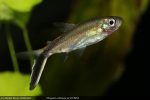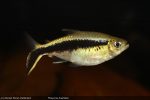In contrast to its close relative Thayeria boehlkei, Thayeria obliqua is only rarely found in trade. The third species of the genus Thayeria ifati is even rarer. I have not seen it myself yet, which might be due to its endemism in the rivers of Maroni and Approuague in French Guyana, from where no exports can be realized. The fourth, recently described species Thayeria tapajonica MOREIRA & LIMA, 2017 originating from Rio Tapajós in Brazil is not in trade either.
 In contrast to Thayeria boehlkei, the black lateral stripe of Thayeria obliqua does not start just behind the gill cover, but behind the dorsal from where it gets stronger in colour towards the caudal fin, it then runs along the lower caudal ray to its end. The lower caudal lobe is clearly longer than the upper one, which is true for all so-called “penguin tetras”, whose diagonal swim with the head upwards is visually emphasized by the dark, laterally running stripes present in all three species. With about 80 mm expected standard length, T. obliqua grows somewhat larger than T. boehlkei, which usually remains somewhat smaller and reaches only 70 mm, although almost equally large specimens have been reported here, but possibly related to the total length.
In contrast to Thayeria boehlkei, the black lateral stripe of Thayeria obliqua does not start just behind the gill cover, but behind the dorsal from where it gets stronger in colour towards the caudal fin, it then runs along the lower caudal ray to its end. The lower caudal lobe is clearly longer than the upper one, which is true for all so-called “penguin tetras”, whose diagonal swim with the head upwards is visually emphasized by the dark, laterally running stripes present in all three species. With about 80 mm expected standard length, T. obliqua grows somewhat larger than T. boehlkei, which usually remains somewhat smaller and reaches only 70 mm, although almost equally large specimens have been reported here, but possibly related to the total length.
 T. obliqua was already described in 1908 by EIGENMANN as T. obliquus and thus represents the type species of the genus, a synonym is T. sanctaemariae (LADIGES, 1951).
T. obliqua was already described in 1908 by EIGENMANN as T. obliquus and thus represents the type species of the genus, a synonym is T. sanctaemariae (LADIGES, 1951).
Due to the fact that the genus Thayeria is not assigned to any subfamily, but the next higher taxon is the family Characidae, it becomes clear that there are still some uncertainties concerning the systematic position. The three known species could therefore possibly be placed in another genus, should there ever be a revision of the genus.
In the hobby these members of the Hemmigrammus clade are also known as “penguin tetra”, whereas only T. boehlkei belongs to the standard assortment of pet shops. T. obliqua originates from the catchment area of the central Rio Tocantins in Brazil, and the Rio Guaporé. Like most small representatives of the tetras (Characidae), T. obliqua is found in the shallower and cooler tributaries and not in the main stream.